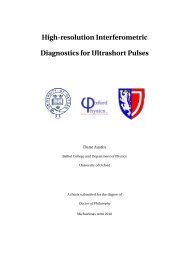Undergraduate Course Handbook - University of Oxford Department ...
Undergraduate Course Handbook - University of Oxford Department ...
Undergraduate Course Handbook - University of Oxford Department ...
- No tags were found...
Create successful ePaper yourself
Turn your PDF publications into a flip-book with our unique Google optimized e-Paper software.
Appendix EFOR THIRD YEAR STUDENTSFinal Honour School - Part BA knowledge <strong>of</strong> the topics in the syllabuses for the four compulsory physics Prelims papers and the compulsory material for Part Awill be assumed. Emphasis will be placed on testing a candidate’s conceptual and experimental understanding <strong>of</strong> the subjects. Theword ‘qualitative’ indicates that the treatment <strong>of</strong> the topic will outline the physical principles involved, may include order <strong>of</strong> magnitudeestimates, but will not be a full mathematical treatment.Each <strong>of</strong> the physics B papers is a 3-hour paper, divided into two sectionsAnswer 2 questions from 4 in each section <strong>of</strong>fered; with each question worth 25 marks.B1: I. Flows, Fluctuations and Complexity, and II. Symmetry and RelativityEach section is 1.5 hour in duration and has four questions.Answer two questions in each section <strong>of</strong>fered.I. Flows, fluctuations and complexityFluxes and conservation principles. Phase-space and Liouville’stheorem. Deterministic and stochastic systems.The Navier-Stokes equation, mass conservation. Solution forPoiseuille flow, Reynolds’s experiment. Dynamical similarity, theReynolds number. Phenomena <strong>of</strong> instability, chaos and turbulence.Vorticity, Kelvin’s circulation theorem. Ideal fluid flows withoutvorticity. Bernoulli’s theorem, lift force, hydraulic jumps. Boundarylayers. Very viscous flows: Stokes’ law, biological motility atlow Reynolds number. Sound waves, shocks. Convective instability,Rayleigh-Bénard convection.Flows in phase space, fixed points, stability, attractors, bifurcations.Lorenz system as a simple model <strong>of</strong> Rayleigh-Bénard convection,strange attractor, aperiodicity and predictability in simplechaotic systems. Fractals, Lyapunov exponents.Simple stochastic processes, Einstein’s theory <strong>of</strong> Brownian motionas an example <strong>of</strong> the fluctuation-dissipation theorem. Moleculardiffusion. Fully developed turbulence, simple Kolmogorov theory,2-d and 3-d turbulence.Freely-jointed chain model <strong>of</strong> the mechanical properties <strong>of</strong> biopolymers.Biomolecular machinery as examples <strong>of</strong> stochasticprocesses; the reaction-diffusion equation applied to molecularmachines. Single-molecule measurements on biological molecularmotors.II. Symmetry & relativityTransformation properties <strong>of</strong> vectors in Newtonian and relativisticmechanics; 4-vectors; proper time; invariants. Doppler effect,aberration. Force and simple motion problems. Conservation <strong>of</strong>energy-momentum; collisions. Annihilation, decay and formation;centre <strong>of</strong> momentum frame. Compton scattering.Transformation <strong>of</strong> electromagnetic fields; the fields <strong>of</strong> a uniformlymoving charge. 4-gradient.The electromagnetic potential as a fourvector;gauge invariance, general solution <strong>of</strong> Maxwell’s equationsusing retarded potentials.Equations <strong>of</strong> particle motion from the Lagrangian; motion <strong>of</strong> acharged particle in an electromagnetic field.Field <strong>of</strong> an accelerated charge; qualitative understanding <strong>of</strong> itsderivation; radiated power, Larmor’s formula. The half-waveattenna; synchrotron radiation.3-d and 4-d tensors; angular momentum and helicity; the Maxwellfield tensor F ; Lorentz transformation <strong>of</strong> tensors with applicationto E and B. Energy-momentum tensor <strong>of</strong> the electromagneticfield, simple applications (e.g. ideal capacitor, solenoid, planewave or similar).2-spinors: rotation, Lorentz transformation and parity; classicalKlein-Gordon equation [Non-examinable: Weyl equations; Diracspinors, Dirac equation.]42









![Extended Notes 8 [pdf]](https://img.yumpu.com/50123548/1/190x245/extended-notes-8-pdf.jpg?quality=85)




![Handout 3 [pdf] - University of Oxford Department of Physics](https://img.yumpu.com/46475432/1/190x245/handout-3-pdf-university-of-oxford-department-of-physics.jpg?quality=85)